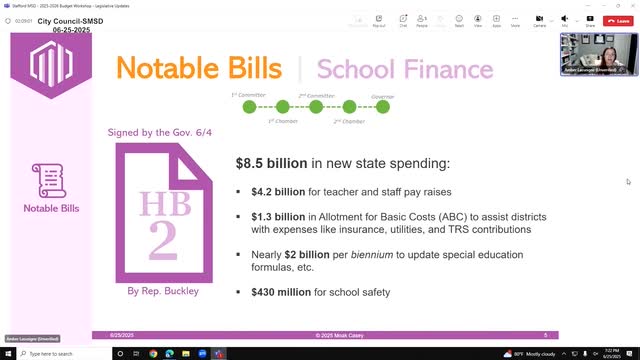Texas Legislature passes $8.5B school funding bill with teacher pay increases
June 30, 2025 | STAFFORD MSD, School Districts, Texas
This article was created by AI summarizing key points discussed. AI makes mistakes, so for full details and context, please refer to the video of the full meeting. Please report any errors so we can fix them. Report an error »

In a pivotal meeting held on June 30, 2025, the Stafford Municipal School District (SMSD) Board of Trustees and the City Council convened to discuss significant changes in school funding and teacher compensation in Texas. The atmosphere was charged with anticipation as board members and city officials delved into the implications of recent legislative reforms aimed at enhancing educational quality and safety.
One of the most pressing topics was the allocation of funds for teachers, which has sparked concern among district leaders. The new funding model, while promising a total of $8.5 billion, has raised questions about its sustainability. A notable $1.3 billion was earmarked for basic costs, but many officials expressed that this amount would not adequately cover essential expenses such as utilities, insurance, and retirement contributions. The basic allotment for public schools saw a modest increase of $55, yet this adjustment was viewed as an accounting maneuver rather than a genuine boost in funding.
The meeting highlighted the importance of special education and school safety, with significant investments of $430 million directed towards these areas. Board members acknowledged the long-standing need for improvements in special education services, emphasizing that while progress has been made, further efforts are necessary in future sessions.
Compensation for teachers emerged as a focal point of the discussion. A substantial $4.2 billion from the funding package is designated for uniform pay increases, with smaller districts receiving up to $8,000 per teacher based on experience. This increase, amounting to an average raise of 8%, was met with enthusiasm from educators, who have long advocated for better pay. Additionally, a new support staff retention allotment of $45 per average daily attendance (ADA) was introduced to support non-teaching staff, including nurses and cafeteria workers.
However, the definition of a "classroom teacher" sparked considerable debate. The Texas Education Code now specifies that only educators teaching at least four hours a day in academic settings qualify for funding, excluding aides and administrative staff. This clarification has led to confusion among districts, as they prepare for the upcoming school year and the necessary data submissions.
As the meeting concluded, the board members recognized the complexities of the new funding structure and the challenges ahead. While the reforms represent a step forward, they also underscore the need for ongoing dialogue and adjustments to ensure that all Texas students receive the quality education they deserve. The discussions at this meeting set the stage for future negotiations, as stakeholders work to refine the funding model and address the evolving needs of schools across the state.
One of the most pressing topics was the allocation of funds for teachers, which has sparked concern among district leaders. The new funding model, while promising a total of $8.5 billion, has raised questions about its sustainability. A notable $1.3 billion was earmarked for basic costs, but many officials expressed that this amount would not adequately cover essential expenses such as utilities, insurance, and retirement contributions. The basic allotment for public schools saw a modest increase of $55, yet this adjustment was viewed as an accounting maneuver rather than a genuine boost in funding.
The meeting highlighted the importance of special education and school safety, with significant investments of $430 million directed towards these areas. Board members acknowledged the long-standing need for improvements in special education services, emphasizing that while progress has been made, further efforts are necessary in future sessions.
Compensation for teachers emerged as a focal point of the discussion. A substantial $4.2 billion from the funding package is designated for uniform pay increases, with smaller districts receiving up to $8,000 per teacher based on experience. This increase, amounting to an average raise of 8%, was met with enthusiasm from educators, who have long advocated for better pay. Additionally, a new support staff retention allotment of $45 per average daily attendance (ADA) was introduced to support non-teaching staff, including nurses and cafeteria workers.
However, the definition of a "classroom teacher" sparked considerable debate. The Texas Education Code now specifies that only educators teaching at least four hours a day in academic settings qualify for funding, excluding aides and administrative staff. This clarification has led to confusion among districts, as they prepare for the upcoming school year and the necessary data submissions.
As the meeting concluded, the board members recognized the complexities of the new funding structure and the challenges ahead. While the reforms represent a step forward, they also underscore the need for ongoing dialogue and adjustments to ensure that all Texas students receive the quality education they deserve. The discussions at this meeting set the stage for future negotiations, as stakeholders work to refine the funding model and address the evolving needs of schools across the state.
View full meeting
This article is based on a recent meeting—watch the full video and explore the complete transcript for deeper insights into the discussion.
View full meeting
